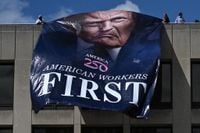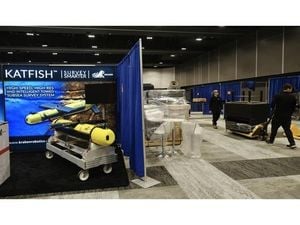On September 16, 2025, a wave of support swept through the federal labor community as the National Federation of Federal Employees (NFFE-IAM) and the International Association of Machinists and Aerospace Workers (IAM) joined forces to endorse the Protect America’s Workforce Act (PAWA). This bipartisan legislation aims to restore collective bargaining rights for over one million federal workers—rights that were abruptly stripped away by an executive order signed by President Donald Trump in March of this year. The move has ignited a fierce debate in Washington, D.C., and beyond, as workers, lawmakers, and union leaders grapple with the implications for civil service and the broader American workforce.
The controversy began on March 27, 2025, when President Trump issued an executive order that unilaterally ended collective bargaining for federal unions, citing national security as justification. The order affected around one million civil servants, denying them the union protections that many had relied on for decades. According to the IAM Union, this executive action was nothing less than "an attack on civil servants and their rights as workers." The National Federation of Federal Employees, which represents approximately 110,000 federal workers nationwide, quickly mobilized in response, calling the order the "biggest assault on working people that we have ever seen in this country," as stated by NFFE National President Randy Erwin.
Erwin was unwavering in his defense of federal sector unionism, emphasizing the long-standing tradition of collective bargaining among government workers. "Collective bargaining in the federal sector is not a threat to national security. It never has been, and it never will be. We have more than 60 years of union representation among federal workers, under both Republicans and Democrats, that proves it," he asserted, according to an official NFFE press release. For Erwin and many others in the labor movement, the executive order represented not just a policy change, but a direct challenge to the very principles of workplace democracy and public service.
In the wake of the executive order, lawmakers from both sides of the aisle began working on a legislative remedy. The Protect America’s Workforce Act, introduced in the U.S. House of Representatives by Jared Golden (D-ME) and Brian Fitzpatrick (R-PA), quickly garnered strong bipartisan support. The bill, officially known as H.R. 2550, seeks to restore the collective bargaining rights that were revoked in March, reaffirming the role of unions in representing the interests of federal employees. According to IAM International President Brian Bryant, who sent letters to both the House and the Senate urging support for the bill, "Federal workers are essential, and they’re committed to serving the American people. These workers deserve the right of collective bargaining, which provides protections in the workplace and better service to the public, just to name a few benefits."
Despite the groundswell of support, legislative hurdles remain. While the bill has attracted bipartisan cosponsors in the House, Speaker Johnson has so far refused to bring it to the floor for a vote. In response, NFFE and its allies have stepped up pressure on lawmakers to sign a discharge petition—a parliamentary maneuver that would force a vote on the legislation if a majority of House members support it. "NFFE is proud to endorse the Protect America’s Workforce Act, which will restore union rights for over one million civil servants," Erwin continued. "The union busting executive order signed by President Trump in March has proven to be detrimental to federal workers and the essential services they provide to the American people every day. This legislation has garnered broad bipartisan support in the House of Representatives and will surely do the same in the Senate."
The stakes are high not only for federal workers but also for the general public, who depend on the services these employees provide. Proponents of the Protect America’s Workforce Act argue that collective bargaining rights are not just about wages and benefits—they are about ensuring that federal agencies can attract and retain skilled workers, maintain morale, and deliver high-quality services to citizens. As Erwin put it, "Lawmakers from both sides of the aisle understand that if this bill is not passed into law, their constituents will suffer the consequences. Thank you to Senator Warner and the initial cosponsors of the legislation for their leadership on this critical issue."
The IAM Union, which represents thousands of federal workers across the country, echoed this sentiment in a call to action published on its website. The union urged members and the public to contact their congressional representatives, writing, "Help us restore collective bargaining for federal workers by sending a letter to your congressional representatives NOW asking them to support the Protect America’s Workforce Act." The IAM has been a vocal advocate for the legislation, emphasizing that collective bargaining is fundamental to workplace fairness and effective public service.
For many in the labor movement, the Protect America’s Workforce Act represents more than just a policy fix—it is a test of the nation’s commitment to the rights of public servants. The backdrop of more than 60 years of union representation in the federal sector, under both Republican and Democratic administrations, lends historical weight to the current debate. As the NFFE and IAM point out, collective bargaining has coexisted with national security concerns for decades without incident. The assertion that union rights pose a threat to security, they argue, is not supported by the historical record.
The road ahead is uncertain. With Speaker Johnson holding firm against bringing the bill to the House floor, supporters are relying on the discharge petition process to circumvent leadership and force a vote. Meanwhile, the Senate is expected to take up companion legislation, with Senator Warner and other initial cosponsors leading the charge. The outcome will likely hinge on continued advocacy from unions, public pressure, and the willingness of lawmakers to cross party lines in defense of federal workers’ rights.
As the debate unfolds, the voices of federal employees and their representatives are growing louder. The NFFE, IAM, and their allies are determined to see the Protect America’s Workforce Act become law, restoring what they see as fundamental rights and protections. Whether the legislation will succeed in overcoming political obstacles remains to be seen, but one thing is clear: the fight for collective bargaining in the federal sector is far from over, and its outcome will have lasting implications for the American workforce and the public they serve.




